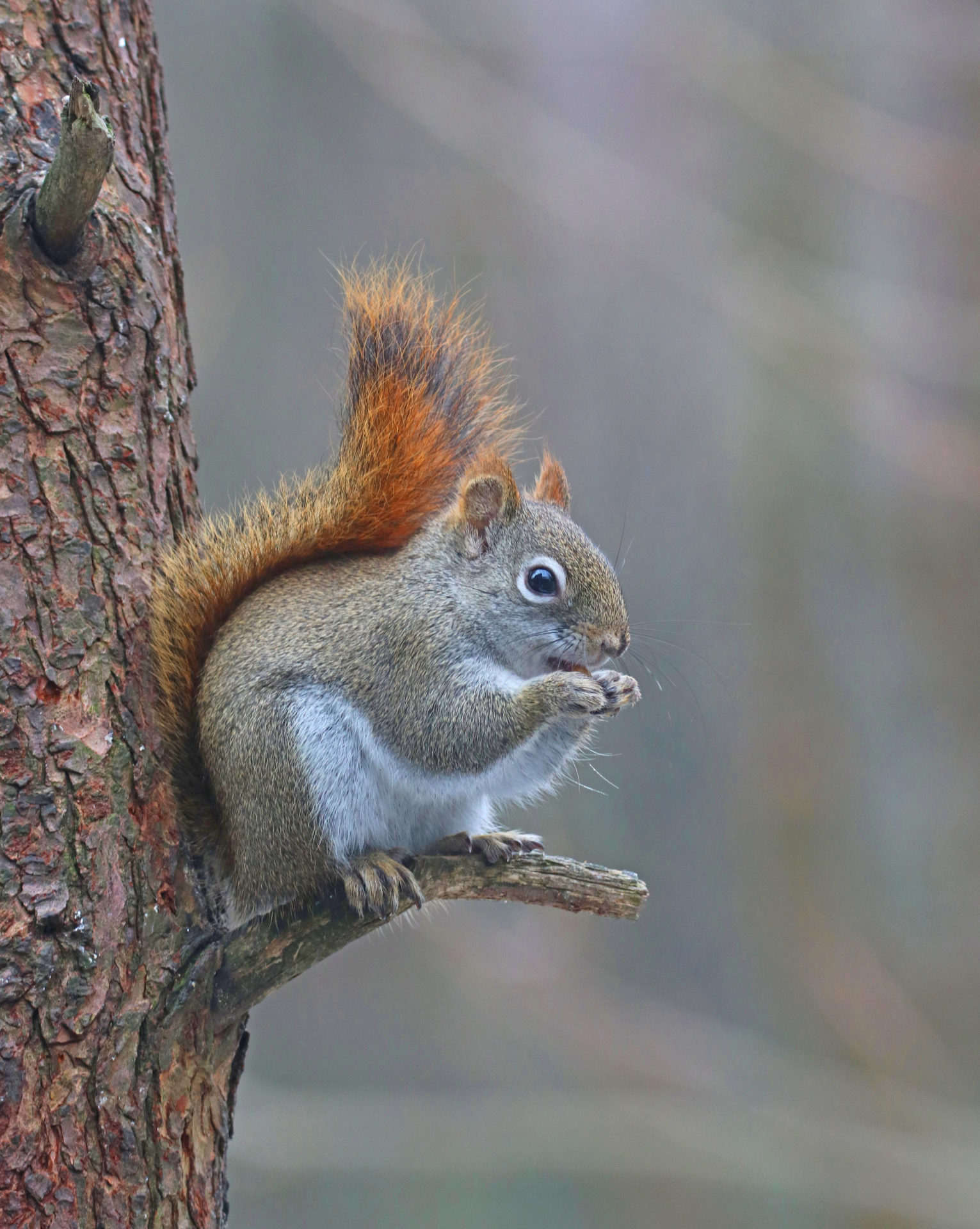A machine-gun-like chatter echoing through the mixed hemlock, beech and maple forest is the scolding that a deer hunter gets when he enters the territory of a feisty red squirrel. Weighing approximately 6 ounces and measuring only a foot long — half of which is tail — the little squirrel packs a large vocal punch.
While deer hunting from a treestand, I enjoy watching the curious red squirrels, but I take care not to disturb them. Their high-volume alarm call would warn the deer in a large area.
The red squirrel (Tamiasciurus hudsonicus) is often called the pine squirrel for its favorite habitat is coniferous forests. It can also be found in mixed hardwood/conifer forests or pure hardwood stands. I live in the middle of a mixed hardwood/conifer forest that is heavy with eastern hemlock trees and red squirrels are common there.
The winter coat of the pine squirrel is quite striking. Its rusty red fur blends with some gray on the sides and ends with a distinctive black stripe before changing to all white on its belly. Its cute face is accented with short ear tufts and white circles around each eye. It must also have a warm fur coat, for red squirrels remain active all winter long, except during the coldest days.
Dens are made in tree cavities at nearly any altitude, high in tree branches, or even in abandoned buildings. Open tree nests are ball-like affairs made of leaves, twigs, and very often strips of bark that have been stripped from wild grape vines. These squirrels also use tree cavities to cache food for use during the winter. In wooded habitat, their home territories consist of approximately 100 yards in any direction from their dens.
Although not “abandoned,” both of my woodsheds are favorite places for red squirrels to make their nests and/or store food. In the woodshed, they stuff the area between the wood and the roof or the spaces between the ranks of logs with leaves, fern-leaf moss, grape vine bark and sometimes pieces of cloth or plastic. I find the nests and lots of shagbark hickory nut husks whenever I transfer wood to my basement for burning.
Red squirrels actively defend their territory and are very aggressive toward other red squirrels and at times toward gray squirrels. However, all will feed peacefully at a bird feeder when times are lean.
Although reds can be observed chasing grays, in areas where the species cohabit, the much larger grays appear to be the dominant species.
There is absolutely no truth to the folk tale claiming that red squirrels castrate gray squirrels.
At the bird feeder, chipmunks stuff their face pouches with sunflower seeds and the hurry away. On the other hand, red squirrels sit on their haunches while using their teeth to crack open sunflower seeds so that they can eat the nutritious heart inside.
Pennsylvania has four squirrel species: the red, gray, fox and flying. The fox squirrel is the largest, and the purely-nocturnal flying squirrel is the smallest. Red squirrels rank next to the smallest. Black squirrels are not a separate species, but just a color phase of the gray squirrel.
Mating season of the small red squirrel runs from February through September, with most females having two litters of three to seven young each year. Young squirrels are weaned and on their own after about two-and-a-half months.
True to its favored habitat, the pine squirrel’s preferred foods are the green cones of the white pine or the seeds of hemlock, pitch pine, larch, Norway spruce or almost any conifer. It also relishes insects, maple seeds, mushrooms, fruit, acorns, beechnuts and hickory nuts. On occasion, a bold red squirrel will raid a bird’s nest for an egg or even a nestling. At bird feeders, they prefer sunflower seeds, peanuts and peanut butter.
Both red and gray squirrels are absent from my feeders whenever the hickory trees are loaded with nuts, so I would rate hickory nuts higher on their preference list than the offerings at my bird feeders.
It is fun to watch red squirrels gathering hickory nuts or hemlock cones. They use their sharp teeth to drop dozens of nuts or cones and then gather them. The late Ned Smith, one of my favorite wildlife artist and naturalist, recorded these observations while archery hunting in Centre County one October. They were published in “Gone For The Day.”
“I have never witnessed such frantic haste. It was impossible to follow his movements as he scrambled about among the bobbing branches, but the steady ‘pat’ of falling cones attested to his industry.
“When he had dropped about twenty (hemlock) cones, he hurried to the ground to bury them.”
Red squirrels are found all across Pennsylvania and throughout most of the United States, except the extreme south. Although they are considered abundant, their numbers fluctuate from year to year. They are preyed upon by a multitude of predators including the black rat snake, coyotes, hawks, owls, weasels, bobcats, foxes and mink.
Mark Nale writes about the outdoors for the Centre County Gazette. This column appears in the Oct. 28-Nov. 3 edition of the Gazette.



